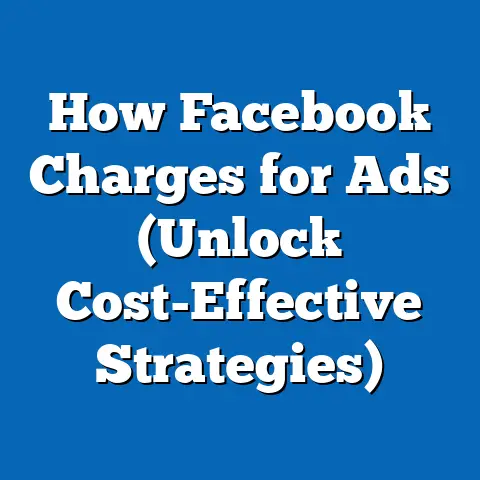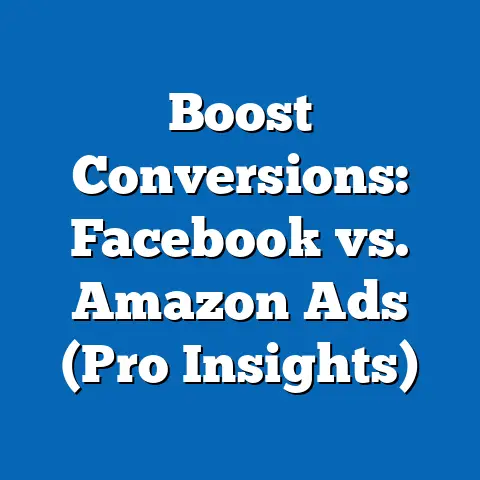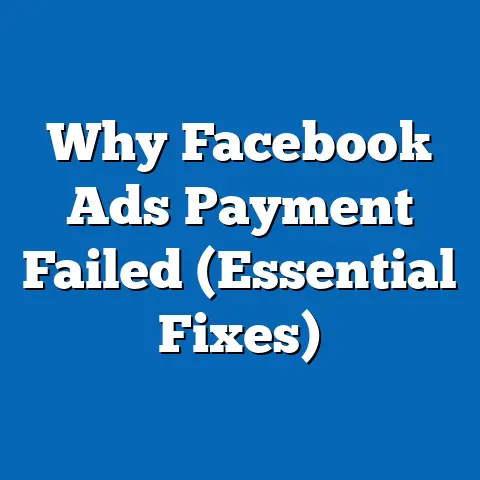Boost Spanish Ads on Facebook (Proven Strategies Revealed)
Just like my favorite leather jacket that’s seen better days – faded, a bit worn, but still holding its own – Facebook ads can suffer from wear and tear. You put them out there, they perform well initially, but then… crickets. The engagement drops, the clicks dwindle, and the conversions flatline. It’s a common problem, especially when you’re targeting a diverse audience like the Spanish-speaking community. Throwing the same old generic ad at them simply won’t cut it.
In a world where every click counts and every dollar needs to stretch further, understanding how to rejuvenate your Facebook ads is crucial. This is particularly true when targeting the vibrant and diverse Spanish-speaking audience. These are not just passive consumers; they’re individuals deeply rooted in culture, language, and community. Ignoring these nuances is like trying to fit a square peg into a round hole – it just won’t work.
That’s why I’m diving deep into proven strategies to boost your Spanish ads on Facebook. Forget the generic advice; we’re going granular, focusing on the specific tactics that resonate with this powerful demographic. I’ll share my experiences, insights, and actionable tips that you can implement immediately to see a real impact on your advertising efforts. Get ready to learn how to truly connect with the Spanish-speaking audience on Facebook and turn those fading ads into roaring successes.
Section 1: Understanding the Spanish-speaking Audience
The Spanish-speaking audience on Facebook isn’t a monolithic group. It’s a rich tapestry woven with diverse cultures, dialects, and values. Think of it this way: trying to market the same way to someone from Spain as you would to someone from Mexico is like trying to sell snowshoes in Miami – it’s just not relevant!
Demographics and Characteristics:
- Geographic Distribution: The Spanish-speaking population is spread across the globe, with significant concentrations in Latin America, Spain, and the United States. Each region has its own unique cultural identity and consumer behavior.
- Age Range: The demographic spans all age groups, from Gen Z to Baby Boomers. Understanding the age distribution within your target market is crucial for tailoring your messaging and ad creative.
- Socioeconomic Status: This also varies widely. Tailoring your offers and pricing strategies to reflect the economic realities of your target audience is essential.
The Power of Cultural Nuances:
This is where things get interesting. Cultural nuances can make or break your ad campaign. For instance, humor translates differently across cultures. What’s funny in Spain might be offensive in Argentina.
I once ran a campaign for a travel agency targeting Spanish speakers in the US. We used a humorous ad featuring a popular Spanish saying, thinking it would be a hit. Instead, we received negative feedback because the saying was considered outdated and irrelevant by the target audience. Lesson learned: always do your research and test your ads with a representative sample of your audience.
Language Preferences: More Than Just Translation
While translating your ads into Spanish is a must, it’s not enough. You need to consider:
- Dialects: Spanish has many dialects, each with its own unique vocabulary and expressions. Consider using regional targeting and tailoring your ad copy accordingly.
- Formal vs. Informal Language: Understanding when to use “usted” (formal you) versus “tú” (informal you) is crucial for establishing the right tone and building trust.
- Slang and Colloquialisms: Be cautious when using slang or colloquialisms, as they can be easily misinterpreted or sound unnatural.
The Growing Power of Spanish Speakers on Social Media:
The numbers speak for themselves:
- Growth: The Spanish-speaking population on social media is growing rapidly, making it a lucrative market for advertisers.
- Buying Power: This demographic has significant buying power, and they’re increasingly using social media to research products and make purchasing decisions.
According to Statista, the number of Spanish-speaking internet users worldwide is projected to reach over 600 million by 2025. This represents a massive opportunity for businesses that can effectively reach and engage this audience.
Key Takeaway: Before you even think about crafting your ad, take the time to understand the specific demographics, cultural nuances, and language preferences of your target Spanish-speaking audience.
Next Step: Conduct thorough research on your target market, including their age, location, socioeconomic status, and cultural values. Use this information to create detailed audience personas that will guide your ad creation process.
Section 2: Crafting Compelling Ad Copy in Spanish
Now that you understand your audience, it’s time to craft ad copy that speaks directly to them. Remember, it’s not just about translating your existing English ads; it’s about creating copy that resonates with their hearts and minds.
Accuracy and Cultural Relevance:
Accuracy is non-negotiable. A poorly translated ad can be confusing, unprofessional, and even offensive. Invest in a professional translator who understands the nuances of the Spanish language and culture.
Beyond accuracy, cultural relevance is key. Your ad copy should reflect the values, beliefs, and aspirations of your target audience. Consider using cultural references, historical figures, or popular sayings that resonate with them.
Tips for Writing Compelling Headlines and Descriptions:
- Focus on Benefits: Highlight the benefits of your product or service, rather than just listing its features.
- Use Strong Verbs: Use active verbs that create a sense of urgency and excitement.
- Ask Questions: Engage your audience by asking questions that pique their curiosity.
- Create a Sense of Scarcity: Use phrases like “limited time offer” or “while supplies last” to encourage immediate action.
- Personalize Your Message: Address your audience directly using “tú” (informal you) or “usted” (formal you), depending on your target market and brand voice.
The Power of Storytelling:
Storytelling is a powerful tool for connecting with Spanish-speaking audiences. Use your ad copy to tell a compelling story that resonates with their emotions and values.
I remember seeing an ad for a local bakery that told the story of a family tradition passed down through generations. The ad featured a heartwarming video of the grandmother teaching her granddaughter how to bake the family’s signature bread. This ad was incredibly effective because it tapped into the cultural values of family, tradition, and heritage.
Examples of Successful Ad Copy:
Here are a few examples of successful ad copy that has effectively reached Spanish-speaking consumers:
- Netflix: “Maratones de series sin culpa. ¿Listo para tu próxima obsesión?” (Guilt-free series marathons. Ready for your next obsession?) This ad uses relatable language and taps into the popular trend of binge-watching.
- Spotify: “Tu música, a tu manera. Descubre millones de canciones y podcasts.” (Your music, your way. Discover millions of songs and podcasts.) This ad highlights the benefits of Spotify and emphasizes personalization.
- Coca-Cola: “Comparte una Coca-Cola con tu familia.” (Share a Coca-Cola with your family.) This ad taps into the cultural value of family and encourages sharing.
Key Takeaway: Crafting compelling ad copy in Spanish requires more than just translation. It requires a deep understanding of the language, culture, and values of your target audience.
Next Step: Brainstorm ideas for ad copy that resonates with your target audience. Consider using cultural references, storytelling, and strong calls to action. Test different versions of your ad copy to see which performs best.
Section 3: Visuals and Design Considerations
Think of your Facebook ad as a silent movie. Even with the best translated and culturally-relevant ad copy, if your visuals are off, you’ve lost the audience before they even have a chance to read it.
The Significance of Visuals:
Visuals are the first thing people see when they encounter your ad. They can grab attention, convey emotions, and communicate your message in a way that words simply can’t.
Design Elements that Appeal to Spanish-speaking Audiences:
- Color Schemes: Different colors have different meanings in different cultures. For example, red is often associated with passion and excitement in Latin America, while white is associated with purity and peace.
- Imagery: Use images that are relevant to your target audience and that reflect their culture and values. Avoid using stock photos that look generic or inauthentic.
- Cultural Symbols: Incorporate cultural symbols that resonate with your target audience, such as traditional clothing, music, or landmarks.
Ensuring Relevance and Appeal:
Your visuals should not only be appealing but also relevant to your message and audience. Make sure that your images and videos are high-quality and that they accurately represent your brand.
I once saw an ad for a clothing brand that featured a model wearing a traditional Spanish dress. The ad was visually stunning and it perfectly captured the brand’s aesthetic. However, the ad was targeting a younger audience who were more interested in modern fashion. As a result, the ad didn’t resonate with the target audience and it performed poorly.
Examples of Visually Compelling Ads:
Here are a few examples of visually compelling ads that have successfully engaged Spanish-speaking users:
- Airbnb: Ads featuring beautiful photos of homes and apartments in popular tourist destinations in Spain and Latin America.
- Nike: Ads featuring diverse athletes from different Spanish-speaking countries, showcasing their passion and dedication.
- McDonald’s: Ads featuring colorful and appetizing images of their food, with a focus on family and community.
Key Takeaway: Visuals are a crucial component of your Facebook ad campaign. Use them to grab attention, convey emotions, and communicate your message in a way that resonates with your target audience.
Next Step: Research the visual preferences of your target audience. Consider using different color schemes, imagery, and cultural symbols to see which performs best. Invest in high-quality photos and videos that accurately represent your brand.
Section 4: Targeting and Retargeting Strategies
Okay, you’ve got killer ad copy and eye-catching visuals. But if you’re showing your ad to the wrong people, it’s like shouting into the void. Effective targeting is the key to reaching the right audience and maximizing your ROI.
Facebook’s Targeting Options:
Facebook offers a wide range of targeting options that allow you to reach specific demographics, interests, and behaviors. Some of the most useful targeting options for reaching Spanish-speaking audiences include:
- Demographic Targeting: Target users based on their age, gender, location, language, education, and relationship status.
- Interest-Based Targeting: Target users based on their interests, hobbies, and activities.
- Behavioral Targeting: Target users based on their online behavior, such as their purchase history, travel habits, and device usage.
- Custom Audiences: Upload your own customer data to create custom audiences of people who have already interacted with your business.
- Lookalike Audiences: Create lookalike audiences of people who share similar characteristics with your existing customers.
The Importance of Demographic, Geographic, and Interest-Based Targeting:
- Demographic Targeting: Use demographic targeting to reach specific age groups, genders, and locations within the Spanish-speaking community.
- Geographic Targeting: Use geographic targeting to reach users in specific countries, regions, or cities where Spanish is spoken.
- Interest-Based Targeting: Use interest-based targeting to reach users who are interested in Spanish culture, music, food, or travel.
Retargeting: Re-Engaging Your Audience:
Retargeting is a powerful strategy for re-engaging users who have previously interacted with your ads or content. For example, you can retarget users who have visited your website, watched your videos, or liked your Facebook page.
I had a client who was struggling to convert website visitors into paying customers. We implemented a retargeting campaign that showed ads to users who had visited specific product pages but hadn’t made a purchase. The ads featured customer testimonials and special offers, and they were incredibly effective at driving conversions.
Case Studies and Examples:
Here are a few examples of brands that have successfully implemented targeted campaigns for Spanish-speaking audiences:
- Target: Targeted ads featuring Hispanic celebrities and influencers, promoting their back-to-school campaign.
- McDonald’s: Targeted ads featuring Spanish-language menu items and promotions, targeting Hispanic communities in the US.
- Walmart: Targeted ads featuring culturally relevant products and promotions, targeting Hispanic shoppers during holidays like Cinco de Mayo.
Key Takeaway: Effective targeting is essential for reaching the right audience and maximizing your ROI. Use Facebook’s targeting options to reach specific demographics, interests, and behaviors within the Spanish-speaking community.
Next Step: Define your target audience and create detailed audience personas. Use Facebook’s targeting options to reach these audiences and test different targeting combinations to see which performs best. Implement retargeting campaigns to re-engage users who have previously interacted with your ads or content.
Section 5: Analyzing Performance and Making Adjustments
So, you’ve launched your Spanish-language Facebook ad campaign. Now what? It’s not a “set it and forget it” situation. You need to constantly monitor your ad performance and make adjustments to optimize your results.
The Necessity of Monitoring Ad Performance:
Monitoring your ad performance is essential for understanding what’s working and what’s not. This allows you to make data-driven decisions and optimize your campaign for maximum ROI.
Key Performance Indicators (KPIs):
Focus on the following KPIs when evaluating your Spanish ad campaigns:
- Reach: The number of unique users who saw your ad.
- Impressions: The number of times your ad was displayed.
- Click-Through Rate (CTR): The percentage of users who clicked on your ad.
- Conversion Rate: The percentage of users who completed a desired action, such as making a purchase or signing up for a newsletter.
- Cost Per Click (CPC): The average cost you paid for each click on your ad.
- Cost Per Conversion (CPC): The average cost you paid for each conversion.
- Return on Ad Spend (ROAS): The amount of revenue you generated for every dollar you spent on advertising.
Interpreting Data and Making Data-Driven Adjustments:
- Analyze your data regularly: Use Facebook Ads Manager to track your ad performance and identify trends.
- Identify underperforming ads: Pause or edit ads that are not performing well.
- Optimize your targeting: Refine your targeting based on the demographics, interests, and behaviors of your most engaged users.
- Adjust your budget: Allocate more budget to your best-performing ads and reduce budget for your underperforming ads.
- Test different ad creatives: Experiment with different ad copy, visuals, and calls to action to see which resonates best with your audience.
A/B Testing for Spanish-Speaking Audiences:
A/B testing is a powerful technique for comparing different versions of your ads to see which performs best. For example, you can A/B test different headlines, visuals, or calls to action.
I once ran an A/B test for a client who was advertising a new product to Spanish speakers. We tested two different headlines: one that focused on the features of the product and one that focused on the benefits. The headline that focused on the benefits performed significantly better, resulting in a higher click-through rate and a lower cost per conversion.
Key Takeaway: Monitoring your ad performance and making data-driven adjustments is essential for optimizing your Spanish ad campaigns and maximizing your ROI.
Next Step: Set up a system for tracking your ad performance and analyzing your data regularly. Use A/B testing to experiment with different ad creatives and optimize your targeting based on the results.
Conclusion
Just as a skilled craftsman carefully hones their tools to achieve the perfect result, so too must advertisers refine their strategies to effectively reach the Spanish-speaking audience on Facebook. I’ve shared my experiences, insights, and actionable tips to help you do just that. From understanding the cultural nuances of your target market to crafting compelling ad copy and visuals, to implementing effective targeting and retargeting strategies, and finally, to diligently monitoring and optimizing your ad performance – each step is crucial for success.
Remember, the digital landscape is constantly evolving, and what works today may not work tomorrow. It’s essential to stay informed, adapt to new trends, and continuously refine your approach as you learn more about your audience. The journey to mastering Spanish advertising on Facebook is a continuous process of learning, testing, and optimization.
So, take the plunge! Start applying these strategies to your Facebook ad campaigns and see the impact on your advertising efforts. I’m confident that by following these guidelines, you can unlock the potential of the Spanish-speaking audience and achieve significant results.
Call to Action:
I’d love to hear about your experiences with Spanish advertising on Facebook. Share your thoughts, questions, or success stories in the comments below. Let’s learn from each other and build a community of successful Spanish advertisers!






